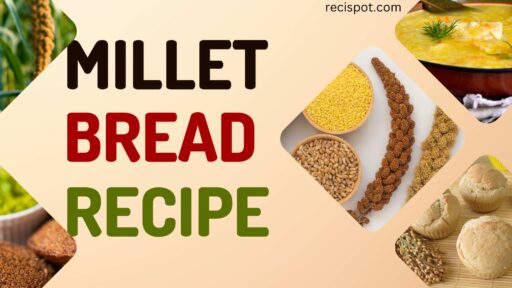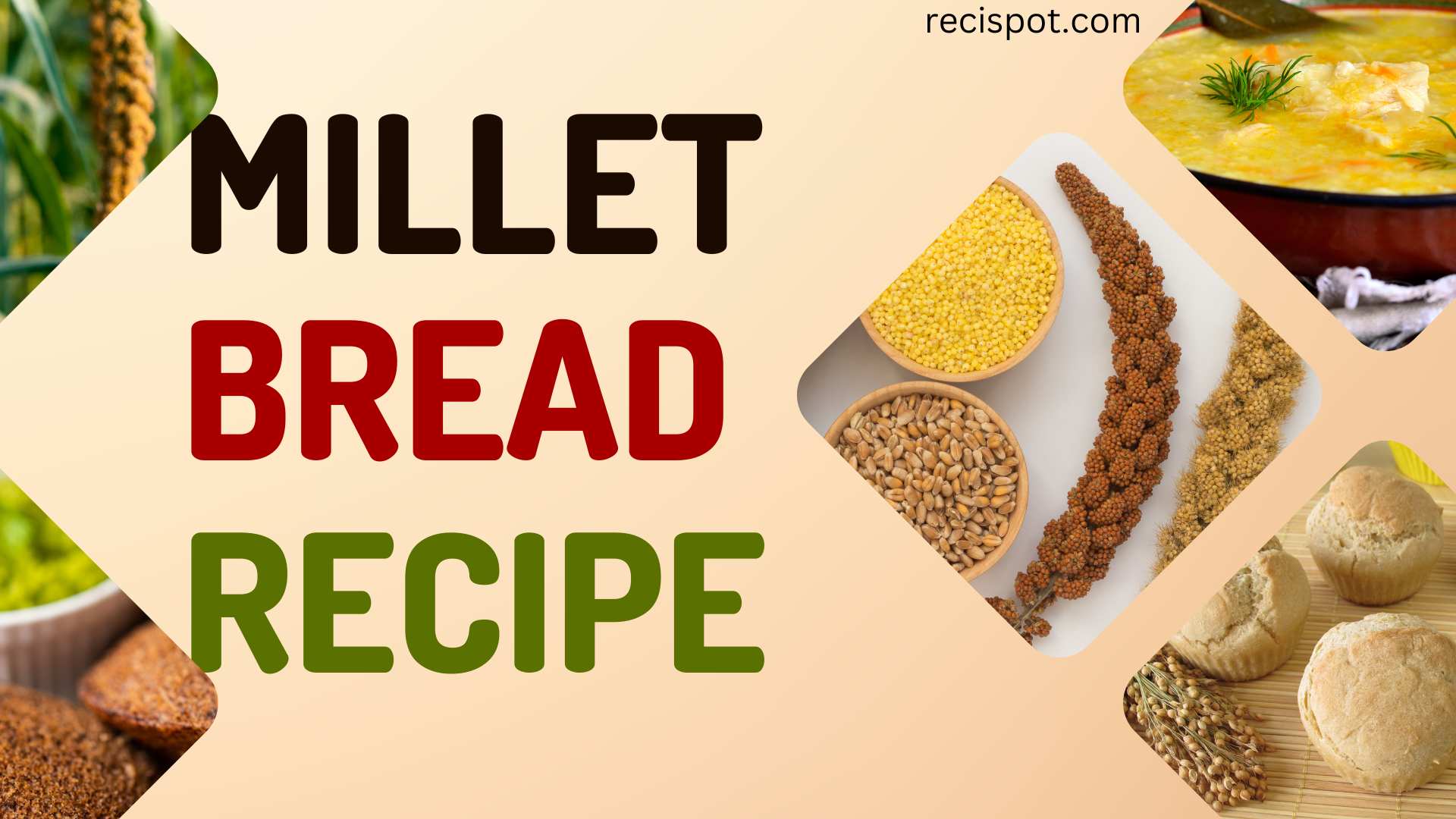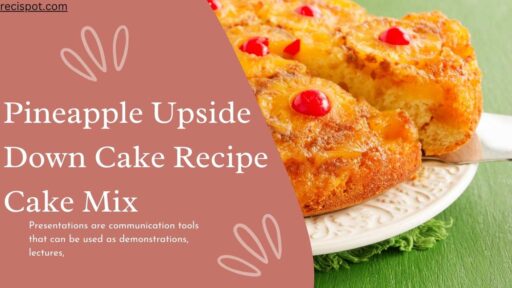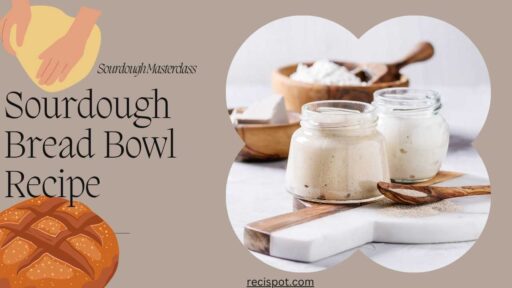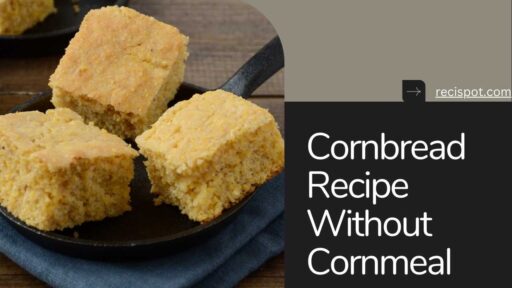Indulge in the goodness of Millet Bread Recipe with our collection of easy-to-follow recipes. Bake your own nutritious loaves with our help.
Introduction to Millet Bread Recipe
Forget about wheat; just take on millet! Millet really stands out, and it can be taken in many ways, including as delicious and healthy millet bread. People looking for gluten-free alternatives would very much appreciate having millet bread because it has a lot of fiber and several body benefits.
And so get ready to try one of two recipes: one with a simple base that is versatile or the other with yeast as well but only slightly different rise. Then preheat your oven and enjoy this yummy place where you belong to.
Why choose millet bread?
The choice to bake breads using millets as the major ingredient may make all the difference when baking. The mildness nuttiness of the flavor which is unique makes it more satisfactory even without any additives. This could become an alternative loaf for variety seekers at your bakery or those who seek or have a certain dietary requirement concerning their consumption of gluten products.
One reason why I’m inclined towards something like millets instead of others is; they are inclusive. It provides full coverage for such kind of bread if you have diabetic friends who cannot eat gluten and others who are moving towards wellness in your pantry. In this way everyone can enjoy homemade loaves without worrying about suffering from some sort of digestive ailment associated with foods containing high amounts of gluten.
In addition, making sweeteners or savories will make any type of meat out of it, hence being good for everyday food consumers. This cereal remains relevant anytime, whether you want to use it during breakfast or dinner – not only something particular but an already acquired habit.
Health benefits of millet bread
Below are some possible health benefits connected with the intake of millet bread:
Gluten-Free: Since they don’t contain gluten naturally, people suffering from celiac disease and those sensitive to gluten should prefer them over anything else.
High in Fiber: Millets provide enough dietary fiber that helps maintain gut health, assists in digestion, and makes a person feel full for a long.
Good Source of Nutrients: Millet contains important vitamins and minerals like phosphorus, magnesium, iron as well as B vitamins which enhance overall wellbeing.
May Help Manage Blood Sugar: When compared with other types of breads, millets possess relatively low glycemic index values suggesting that their increase in blood sugar levels could be slower. This can be beneficial to people suffering from diabetes or those at risk of developing it.
Potential Benefits for Heart Health: In some research, we read that the common fiber type present in millets lowers cholesterol; moreover, it has been illustrated how certain plant compounds are responsible for this.
Additional Considerations
However, while millet bread may have all these potential benefits but is worth noting that its calorie content might slightly exceed that of some wheat breads. It follows average intake level.
In the opposite to millet loaf’s texture denseness compare to traditional wheat flour made bread. And that is exactly what happens because many people find it really difficult to eat it only at first.
Overall
This article, in particular, examines how millet bread provides a delicious and healthy alternative to the traditional wheat loaf. It is one way of healthy eating because of its high fiber content and gluten-free nature. Millet bread is therefore recommended for anyone looking to increase their fiber intake or try other types of gluten-free products.
Millet Bread Recipe Ingredients
Ingredients For Millet Bread Recipe – Two Options!
You can use different ingredients to make millet bread which serves as a good substitute for conventional wheat breads. Here are two options that can guide you.
Option 1: Gluten-Free Millet Bread (Simple and Versatile)
It’s meant for those who may not want glutens, among others.
Dry Ingredients
- 2 ½ cups (400 grams) of millet flour (not sorghum or amaranth)
- Two teaspoons of baking powder
- ¾ teaspoon fine sea salt (adjust to taste)
- ½ teaspoon baking soda
- Wet Ingredients:
- 2 ½ cups (593 ml) water
- One tablespoon cider vinegar (see notes for options)
- ⅓ cup (27 grams) whole psyllium husks(not psyllium powder)
- Option 2: Easy 100{077506c382e4b8c3703f024bbc993369fa1f1e3db22592727ebcb72d89699b66} Millet Bread (More Yeast-Focused)
- For a slightly different texture and rise, this recipe uses yeast.
Dry Ingredients
- 26gms of whole psyllium husk
- 400grams millet flour
- 7-10 grams salt(adjust to taste)
- Wet Ingredients:
- 2 ½ cups(565gms) water(use some for activation if using active dry yeast)
- 20 grams fresh yeast OR 7g instant yeast(activate if using active dry yeast)
- 2 teaspoons sugar(for the yeast)
- 1 tbsp apple cider vinegar(16g)(see notes for options).
Additional Notes
Cider vinegar helps activate the psyllium husks with a touch tang whilst lemon juice or any other acidic ingredient can be used instead.
Also, there might be other variations that may have some more ingredients like honey, nuts, seeds and dried fruit among others.
The amount of water can vary slightly depending on the brand of millet flour you are using because is absorbers differently between brands.
Remember: These are just starting points! With a little bit of creativity and experimentation, you will find your perfect millet bread recipe for your taste buds and dietary requirements.
Step-by-step instructions for making millet bread
Preparing the dough
In a big mixing bowl, blend millet flour, psyllium husk powder, and salt.
Warm water with honey (or maple syrup) and oil in another bowl. Add instant yeast let sit for some minutes until frothy.
Slowly pour wet ingredients into dry ones while stirring constantly. The dough should come out mixed evenly.
Knead on floured surface about 10 minutes till smooth elastic; add a little more if necessary but avoid drying too much by adding extra rice flour.
Proofing the dough
Put the dough into greased bowl then cover with damp cloth or plastic wrap. It should increase to double its size in around an hour as it rises somewhere warm.
After rising gently, push down to release air bubbles and shape it into a loaf.
Baking the bread
- Preheat oven to 350°F (175°C).
- Transfer the shaped loaf onto a parchment paper-lined baking sheet or well-greased bread pan.
- A wet cloth should cover the loaf and leave it on for about 30 minutes.
- The oven should be heated so as to bake the bread at this temperature for about 35-40 minutes until its top is golden brown and sounds hollow when tapped on its bottom side.
- Take out of the oven on a wire rack first before slicing after cooling.
Millet Bread: The Definitive Process
Millet bread requires several steps to achieve good results. Do not hurry; let it be a pleasure.
How To Make The Best Millet Bread Ever
It takes practice to make perfect millet bread; it is not an overnight project. Here are some tips that could help:
Little changes in these ingredients
Millet Flour: Choose finer quality, flours that have been milled more finely will give you more even consistency. If you grind your own flour, ensure that it’s well-milled.
Psyllium Husk: This acts as a binder in gluten-free baking. The amount may vary depending on how much structure or crumb one prefers with too little making it crumbly while a bit too much makes denser loaf.
Water Balance: Millet absorbs moisture dissimilarly as compared with wheat flour; therefore, start with slightly less water than recipe states so as to end up with the dough that is sticky but not wet.
Technique Tips You Need To Know
Mixing Matters: Over-mixing dough will make it heavy in texture.
Rest and Rise: Allow dough to rest for about 15 minutes immediately after mixing. This allows psyllium husks time to absorb some moisture thus adding texture.
Baking Bliss: While baking, use metal pans that distribute heat evenly throughout. Fully preheat your oven to ensure the baking of all parts of your bread is even; consider lining the pan with parchment paper for ease of removal later on.
Why Not Experiment?
Flavor Boosters: Perhaps just add a dash of honey or maple syrup for sweetening, some warm flavored ones such as cinnamon and nutmeg are good.
Nutty Additions: These should be reserved to add some texture as well as an additional nut-like flavor. Chopped walnuts or almonds can do the trick.
Embrace Moisture: On the other hand, you could introduce dried fruit like raisins, cranberries, and so on, which would cause a burst of sweetness and moisture.
This Goes Without Saying
Millet bread is denser than wheat bread. That’s ok; enjoy the unique texture!
Play Around with it. With practice and these tips, you will find your own perfect millet bread recipe and method.
By following this paragraph’s advice and getting creative in terms of flavor combinations, you could start producing lovely fresh loaves of millet bread that are both delicious and nutritious.
Different ways to make millet bread
Once you have mastered making the basic recipe for millet bread, try some fun variations. The following ideas may be beneficial during your next time in the kitchen:
Add seeds and nuts: They might add more crunchiness to a loaf while also boosting its nutritional value. Sunflower seeds, pumpkin seeds, almonds etc.
Change flours: Mix almond flour or buckwheat (also gluten-free) with your millet flour to give it more depth than ever before.
Incorporate herbs and spices: Put rosemary leaves, either fresh or dried, into the dough while baking to get a great smell throughout your house.
Mix in some good stuff: Another suggestion is to include dried fruits such as cranberries, raisins or dates that have been chopped for those who like a sweeter loaf.
These are just a few suggestions that could make your millet bread more tasty according to your mood or personal preference.
How long does Millet Bread last?
Shelf Life Guidelines – Millet Bread Storage And Enjoyment
Freshly baked millet bread smells heavenly and tastes amazing, but how long will it last? Read on below to get a detailed account of how to store it and its shelf life so you can have your millet bread still at its best:
Storage Strategies
Room Temperature (Short Term): To avoid drying out wrap cooled millet bread in plastic wrap or clean kitchen towel. This way, you can keep any leftover bread for up to two days at room temperature.
Refrigerator (Extended Storage): For longer storage, cut cooled bread into slices and pack them into an air tight container then refrigerate. This may extend the shelf life up to 3-5 days.
Freezer (Long Term): Instead of putting the sliced loaves straight into a freezer, leave them to cool down first before placing them inside airtight containers or freezer bags. Well, frozen ones could go for up to three months.
Tips for Optimal Freshness
Minimize Slicing: Only slice what you need; otherwise, there may be dry spots on top.
Label and Date: Remember when your saved loaf was made by writing its date of production on it.
Reheating and Enjoying
Room Temperature Slices: When ready for quick pick-me-up, retrieve required slices from fridge/freezer allowing them time in room temperature before consumption.
Toasted Perfection: If you like your warm with nice crispiness toast the millet bread slices in toaster oven/toaster until they turn golden brownish.
Remember
The quality and texture of millet bread may change slightly over time. Moreover, despite different textures when defrosted, frozen bread is still edible.
By following these storage and reheating tips, you can ensure you enjoy your homemade millet bread for days or even weeks to come!
Frequently asked questions about millet bread.
Baking with millet flour may raise some questions, especially for those new to gluten-free baking. Here are answers to some common queries:
Is millet bread gluten-free?
Yes, as a grain, it does not contain any gluten, making it naturally gluten-free.
Can I use active dry yeast instead of instant yeast?
Absolutely! However, make sure you dissolve the yeast in warm water before adding it into the other ingredients.
Why didn’t my millet bread rise?
It could be due to a few things like using expired yeast, using water at the wrong temperature, or not giving dough enough time to rise. Make sure that your yeast is fresh, the water is warm (but not hot), and give the dough enough time to rise.
Is Millet Bread suitable for Vegans?
Sure thing; honey can be replaced by maple syrup or any other plant-based sweetener so that this becomes vegan-friendly.
When you are done with these FAQs, it is guaranteed that you will be able to successfully tackle any obstacles that come your way during the baking process.
Conclusion: Relish your homemade Millet Bread Recipe
Baking of Millet Bread Recipe is a great experience that should end up in a loaf that’s not only pleasing to the taste buds but also beneficial for your body. If you need an alternate free gluten option or just want to experiment, then try this recipe for Millet bread and include it as one of your baking recipes.
Practice makes perfect when it comes to making Millet Bread Recipe. There is nothing more satisfying than getting a freshly baked loaf out of the oven. So take up the activity and assume all deviations the way they are, and let those who love you enjoy your homemade millet bread.
You can definitely bake with pleasure until you’re satisfied—one slice at a time!

